#minolin baenre
Text
bored, looked up drow name meaning
Jarlaxle - prefix Jhul/Jar: charmed, rune, symbol; suffix cyrl/axle: ally, companion, friend. -> charmed friend? symbol of ally? If he were born female, his name would be... Jhulcyrl. Barely pronounceable.
Gromph Baenre - suffix oyss/omph: binder, judge, law, prison. His female name counterpart could be... Groyss...
Triel Baenre - Triel/Taz: bat, winged.
Minolin Fey-Baenre - prefix Min/Ran: lesser, minor, second; suffix olin (unisex): ascension, love, lover, lust. -> minor lover? second lover? Tbf she is the second named lover of Gromph in the series. Very... plot relevant name.
Minthara Baenre - prefix Min/Ran: lesser, minor, second; suffix thara/tar: glyph, marker, rune -> lesser glyph, second rune... glyph jr.? Kind of a cute name meaning from what we've seen.
Nalfein Do'Urden - prefix Nhil/Nal fear, horrible, horror, outraged; suffix ffyn/fein: minstrel, singer, song -> fear singer? song of outrage? horror minstrel... Nhilffyn would be his female counterpart.
Dinin Do'Urden - prefix Gin/Din berserk, berserker, orc, wild; suffix inil/in lady/lord, rider, steed -> berserk rider? wild steed? berserk lord. Gininil is a bit of a tongue twister...
Drizzt Do'Urden - prefix Jys/Driz hard, steel, unyielding; suffix zyne/zt finder, hunter. -> unyielding hunter?
Zaknafein Do'Urden - prefix Zar/Zakn: dusk, haunted, shadow; suffix afae/afein bane, executioner, slayer. Dusk slayer, haunted bane, shadow executioner. His name's female counterpart would be Zarafae. However, in "Relentless", it is stated that Zaharina is the feminine of Zaknafein.

Baby girl is named after her grandpa <3
Malice Do'Urden - Prefix Mal/Malag: mystery, secret; suffix ice/eth: obsession, taker, taken -> secret taker. So her name means something in drow and it's a coincident that it makes up a word that has meaning in Common.
Briza Do'Urden - prefix Briz/Berg graceful, fluid, like water; suffix a/agh breaker, destruction, end, omega -> graceful end.
Vierna Do'Urden - prefix Vier/Val black, dark, darkness; suffix na/nar adept, ghost, spirit -> darkness's adept.
Maya Do'Urden - prefix May/Mas beautiful, beauty, silver; ; suffix a/agh breaker, destruction, end, omega -> beautiful destruction.
For all that she did, gotta give it to Matron Malice when it comes to the naming department. She knows how to give name that's got a good balance on both the meaning and pronounceability.
Sorn Orlith - prefix In/Sorn enchanted, spell.
Nym Orlith - prefix Myr/Nym: lost, skeleton, skull. According to the list, Nym is a male prefix?
Viconia DeVir - prefix Vic (unisex) abyss, deep, profound; suffix onia/onim rod, staff, token, wand. -> abyss' wand.
bonus:
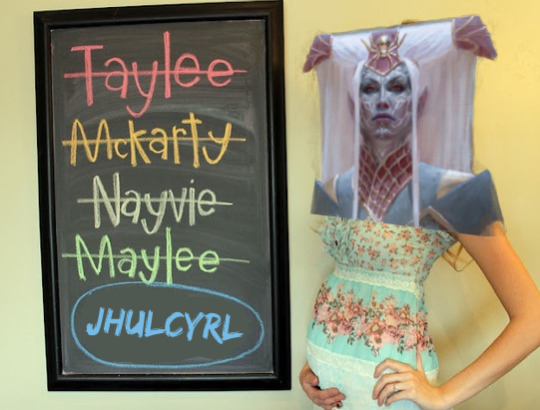
Matron Baenre had a LOT of children and so a tonne to name. Idk how she did it or if she give up after the first... 5 and just go for a dice roll for the rest.

I wasn't able to find the meaning for a few name, like Quenthel's. Also some prefix seen in existing drow's names like Sos in Sosdrille and Sos'Umptu is not in the list.
#jarlaxle baenre#gromph baenre#triel banere#minolin baenre#minthara#nalfein do'urden#dinin do'urden#drizzt do'urden#zaknafein do'urden#malice do'urden#briza do'urden#vierna do'urden#viconia devir#sorn orlith#nym orlith#maya do'urden#lore
88 notes
·
View notes
Photo
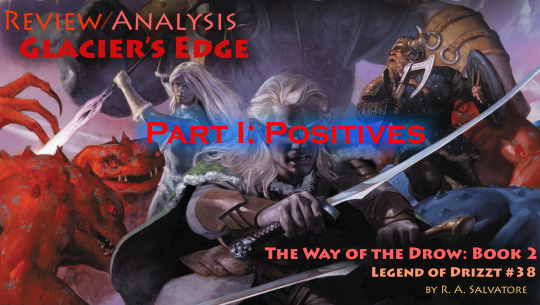
[[ This post contains Part 1 of my review/analysis of the Forgotten Realms/Drizzt novel, Glacier’s Edge, by R. A. Salvatore. As such, the entirety of this post’s content is OOC. ]]
Genre: Fantasy
Series: The Way of the Drow: Book 2 | Legend of Drizzt #38 (#35 if not counting The Sellswords)
Publisher: Harper Collins (August 09, 2022)
My Rating: 2 out of 5 stars
Additional Information: Artwork for the cover of Glacier’s Edge and used above is originally done by David Palumbo. This post CONTAINS SPOILERS. Furthermore, this discussion concerns topics that I am very passionate about, and as such, at times I do use strong language. Read and expand the cut at your own discretion.
As of this point, I am still finishing this document. I will be posting the subsequent sections. The table of contents will be updated when it is complete.
Contents:
Introduction
I. Positives (you are here)
I.1 Sublime Similes and Marvelous Metaphors
I.2 Other Effective Imagery
I.3 Consistent Lore and Decent Worldbuilding
I.4 Respectable and Respectful Characterization
II. Neutrals
III. Negatives (Technical Writing)
IV. Negatives (Characterization)
V. World Breaks
VI. Religious Commentary
VII. Ego Stroking
VIII. Problematic Themes
IX. What’s Next
Positives
Overall, the technical aspect of the writing in Glacier’s Edge is better than a lot of Salvatore’s work. It shows a noticeable reduction in what I’ve dubbed "Salvatorisms", which are negative writing quirks belonging to this author that repeat entirely too frequently. His favorite adjectives “fine” and “magnificent” are used in moderation. There aren’t as many two word sentences. He doesn’t abuse the “how [character] did this [action]!” construction as much as he does in other books, hopefully this means that he’s finally realized that stating "how" something performs an action, such as, "how clumsy and slow it appeared" and "how unusual it was to see both of his eyes", still doesn't actually convey much of anything no matter how often he uses it. The combat scenes are better described, featuring fewer scenarios reminiscent of stop-motion screens from Hollywood C-list movies and not well thought-out details that try to pass as masterful combat maneuvers.
Sublime Similes and Marvelous Metaphors
There are decent if not solid examples of writing in Glacier’s Edge. Salvatore does employ some good analogies and turns of phrase. This section discusses the effective similes and metaphors that can be found within the book.
Metaphors are often good implements in writing because they show rather than tell, but what makes a good metaphor is not only the ability to be illustrative. To be properly evocative, a metaphor also needs to convey a mood that is appropriate to the situation. One such successful metaphor is, “the priestess Minolin Fey Baenre wore the look of a displacer beast after cornering a giant rat”. In this scene, Minolin Fey, a lesser female, is gaining an advantage over Sos’Umptu Baenre, who is both a priestess of Lolth in high favor as well as being a member of Menzoberranzan's ruling council. The metaphor properly conveys the balance of power in this scenario. In addition, like drow, displacer beasts are denizens of the dark, graceful and deadly yet possessing an inexplicably magnetic and exotic beauty. Finally, Minolin Fey is scoring quite the big one against Sos’Umptu, and the reader can feel her degree of satisfaction as a hungry predator would upon finding a sumptuous meal. It can even be stated that the employment of “rat” in this metaphor takes it one step further, as the saying, “I smell a rat”, means detecting that not everything is as it appears, which is especially appropriate in this case, as Sos’Umptu is bringing typical Lolthite intrigue and misdirection to the table.
Similes, on the other hand, are often thought to be easier to use than metaphors due to the direct employment of words that indicate that a simile is present, such as “like”. However, in reality, too many people rely on the “like” to do the work for them, not being careful to ensure that the comparison works on its own merit. Salvatore is definitely guilty of that reliance, but one simile in Glacier’s Edge that is successful is, “The eight hundred fighters of the Blaspheme hit the left flank of the attacking drow force in waves, like sheets of rain blown on furious winds.” Despite Salvatore going on to detail the battle, none of the descriptions that follow convey the situation as well as that one sentence does. Be it walking, riding a bike, or driving, anyone who has encountered rain that’s falling so hard that it can be described as sheets instantly remembers the intensity of the phenomenon. It immediately brings to mind the sense of helplessness and dismay as such a downpour thoroughly drenches a person, totally obstructs their view, and/or instantly renders the road dangerous terrain. Just by itself, “sheets of rain” already convey that the opposing force is routed, but the addition of “on furious winds” further illustrates how little of a chance they had from the very beginning. Even a bit of rain with heavy winds can be pretty intimidating weather, but with heavy rain, high winds can make it appear as though the rain were going horizontally. I’ve not personally seen sheets of rain combined with the type of wind that makes rain go horizontally, but it is a frightful phenomenon to imagine. In this battle, the Blaspheme are, to use a cliché, cutting through the Lolthite army like a hot knife through butter. While that cliché is technically also a simile, it would have been a writing fail due to its overuse. Good on Salvatore for not employing a cliché in this scenario.
In the same vein as the previous, “for the Blaspheme whirlwind was spinning out beyond him, driving their enemies like a panicked herd of rothé” is another effective simile, or more accurately, a metaphor and a simile. This imagery calls to mind an almost comical Wizard of Oz-esque scene in which a tornado rips through an idyllic farm backdrop, with panicked cows running every which way. It’s a fitting image indeed, for, as discussed above, those who oppose the Blaspheme have little chance. The analogy is also charming in the employment of the mention of rothé, which are the cattle that the Underdark societies cultivate. As with the displacer beast comparison, it hits an additional sweet spot by citing a creature that is both familiar to the reader and appropriate to the setting.
The aforementioned charm is also present in, “The webs are hers alone to pluck, like the strings of an abyssal lute, to make the song she determines.” The character being mentioned here is none other than the Spider Queen, Lolth. Everything about this metaphor and simile fits so well. The webs can refer to the literal webs in Lolth’s domain, the Demonweb Pits, the metaphorical “webs” of intrigue that define her people’s societies, the web-like layout of Menzoberranzan, and really, anything and everything about the drow who worship her. It harkens to the Demon Weave and even the web of blasphemy that Quenthel and Yvonnel wove on the surface, although Salvatore likely didn’t intend it quite so thoroughly. Nonetheless, whatever those silky strands may refer to, Lolth, plucking them, could be a puppetmaster directly pulling the strings attached to the drow, or a maestro playing the tune to which they dance. Furthermore, the lute is a setting-appropriate instrument, an abyssal version of which feels like it would especially suit a dark goddess. There’s a sense of delicateness in this imagery, with a lurking hint of threat, as one would expect if imagining the once beautiful elven goddess Araushnee plucking the strings with her graceful and delicate hands, except the whole is twisted and warped by darkness, she into the form of a grotesque giant spider, and her tune into the haunting chords of the Underdark.
Another effective simile is the one contained in, “Eskavidne paused and sighed, a truly grumbling sound in her melted-candle form, like an underwater burp from a hill giant.” Although no reader has witnessed any kind of emissions from a hill giant and perhaps not many have witnessed underwater burps from any creature, all would know what a burp sounds like. It’s then easy to imagine the gurgling quality added by the underwater aspect, as well as a definitive moistness to the sound. Both that gurgling and moistness befit a creature that resembles a lump of melted wax, but the association with the hill giant, in addition to reminding us that these handmaidens are very monstrous and unnatural beings, possesses that charm of fitting in with the setting. The first part of the sentence is actually pretty bad, with the nondescript adjective “truly grumbling”, which might be one of the worst examples of telling instead of showing. Although it would have benefited from not having the first part at all (or just the simple drop of the “truly” part), the sentence is saved by the effective simile.
In this sentence, “He went right past Savahn, whose open hands were drumming the life out of the other gnoll, every strike just ahead of its attempted block, or just behind, just far enough so that the blocking arm had moved up too high.”, an effective simile once again saves the day. The comparison of the attacks of an unarmed martial arts master to playing an instrument that defines the rhythm of an entire performing ensemble is rather poetic. When we think of drumming, we think of sounds that reverberate through the listener’s body, but unlike bursts of a firework, they are balanced and measured. There’s even a reciprocity in this simile, with our knowledge of Savahn being at the top of her order feeding into an assumption that the drumming would be that of an accomplished percussionist rather than a novice one. We can feel how that “performance” is so resounding that it makes one want to clap one’s hands over one’s ears, yet at the same time the cadence is so compelling that the listener, much like the gnoll, is entirely trapped within the musician’s thrall. Without this simile, the sentence would just be a stiff, stop-action description with none of the imagery and the flow.
Another effective simile is in the sentence, “Galathae went up to her knees, then fell to a sitting position, legs gripping the crystal beam as if she were riding a fat horse.” While technically, a fat horse would neither appreciate nor tolerate having a rider grip it in that fashion, nor would a rider want to do so, this simile conveys the intended image perfectly. Perhaps it might be aided in probability by specifying an “unsaddled fat horse”, but it’s fine on its own due to how evocative it is. With just eight words, the simile conveys that the crystal beam is very thick, that Galathae has to spread her legs wide, and that it’s not a comfortable “ride”, all without carrying any of the inappropriateness that my explanation does.
Other Effective Imagery
The passages discussed in this section show that Salvatore can write evocatively without the usage of similes or metaphors. The sentence, “‘Hehehe,’ the green-bearded dwarf said, nodding so hard that his lips flapped through the response.”, is one such example. Salvatore didn’t even need to include the words, “so hard”, for someone would have to have unreasonably disproportionate lips to have them be able to flap with normal nodding. Even so, most people and creatures wouldn’t be able to flap their lips even if they were to nod hard enough such that their heads detached from their necks under the strain, so this descriptor does a good job of calling to mind Ivan’s appearance: that he is a member of a fictional race of humanoids with significantly more pronounced facial features than we have, that he’s elderly and that his skin has loosened significantly with age, and that he’s a comical character. Using descriptors that allow the reader to see rather than be told what’s going on can have the excellent side effect of also conveying things beyond what is seen, such as personalities.
The sentence, “He managed to put the dark thoughts aside as the day wore on, as the world rolled out beneath him, but when they landed that second day, it all chased Drizzt back down to the earth.”, contains a good turn of phrase, namely the final part. The sentence actually starts out pretty awkward, the repeat of the words, “as the”, almost makes it feel run on, and it would benefit with the replacement of the second “as the” with “and”. However, the last phrase ties the whole together well, emphasizing how Drizzt was figuratively and literally flying high, then figuratively and literally grounded and low.. The parallel between the literal and the figurative up and down feels neat and complete.
Allefaero, a new aevendrow character introduced in Glacier’s Edge, is one of the few instances in the book of showing rather than telling. We get to know him best of all in the following passage:
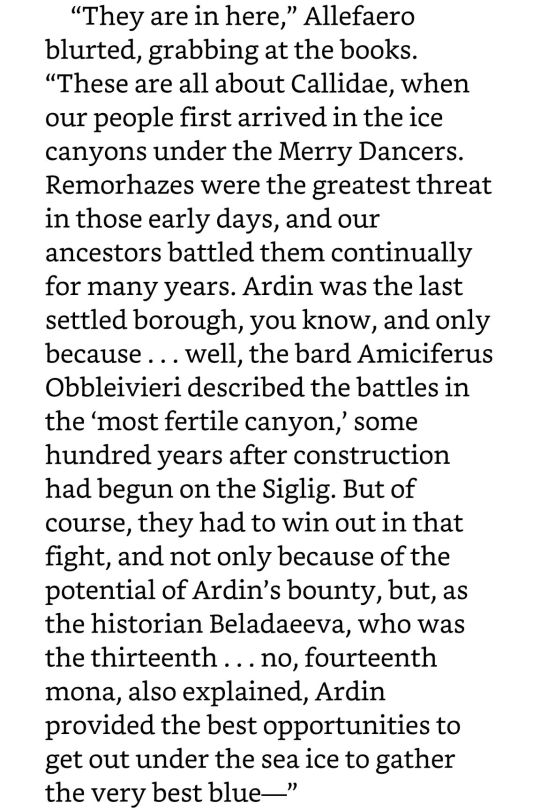

In this page and a half on a smartphone Kindle app, we learn about a bunch of disjointed Callidae history. Allefaero’s rambling, complete with cataloging the details of the personnel involved down to the phrases that they coined, paint a better picture of a gawky young wizard perfectly befitting the nerd stereotype more so than any of the passages describing him before does. Even though every aspect of this recounting is almost certain to never come up again, it is a more worthwhile expenditure of pages than pretty much all of Salvatore’s combat scenes because it conveys the essence of the character well despite none of the words being about him personally.
Another solid piece of imagery is found in the following: “It flashed up at Ygorl, striking the smoky slaad, which made Ygoril itself look like a thundercloud, the arcs of lightning flickering about the ribs and bones within the dark cloud of the being.” At first glance, this might seem like a metaphor, but it actually isn’t, for Ygorl the slaad god (in Salvatore’s presentation anyway) has a body that’s literally dark fog/smoke, making it rather cloud-like. Taking advantage of that aspect to illustrate how a lightning attack would affect the creature is poignant.
This section and the previous one contain examples demonstrating that Salvatore can write decently. Why he ends up not doing so for the most part, be it by choice or otherwise, is anyone’s guess.
Consistent Lore and Decent Worldbuilding
Although outnumbered by the times that he breaks or changes existing lore, sometimes Salvatore does hold true to it, which is always really nice to see.
One of the things that I really appreciate that Salvatore doesn’t neglect is the specification of the relative sizes between male and female drow. As an author who tends towards socio-normalization within Western cultural standards, I find it both astonishing and pleasing that he doesn’t forget that canonically, female drow are larger than male drow. No matter how many times he mentions it, I’ll always compliment him for doing so, as he does in Glacier’s Edge:

There isn’t any precedence for the other revelations in this passage. Although established drow history states that there have been female warriors, none of the sourcebooks say anything about any period of time in which female drow being the best warriors or dominating the warrior rank. However, it wouldn’t be terribly unreasonable for that to be the case in a species in which the female members are larger and stronger than the male members. Furthermore, as this is a recounting by a character, like any verbally-delivered message it could be subject to exaggeration or an inaccurate memory. In this particular case, the character speaking is someone who’d spent millennia in the Demonweb Pits as a drider, and while she seems sound of mind, it wouldn’t at all be unreasonable to apply the unreliable narrator explanation to her. Assuming that female drow dominated the warrior role in the past, it also wouldn’t be unreasonable for fighting styles to change if that role became overtaken by a section of the population that is not only smaller, but also possessing different muscular development. Assuming that drow are like us, male drow would have more developed upper body muscles while female drow would have more developed lower body muscles. Of course, Salvatore doesn’t specify how the fighting styles changed, but perhaps the female-dominated style involved more lower body action or even totally different weapons, while the male-dominated style focused almost exclusively on the weapons wielded in hands. This is just a wild speculation however, as it isn’t a totally safe assumption because we haven’t been told either way and a fantasy race doesn’t necessarily have to have their sexes differentiated in the same way, or, in fact, in any way. Nonetheless, the premise put forth by Salvatore here isn’t wholly impossible.
Another creature that Salvatore portrays well in Glacier’s Edge is the illithid adviser to the drow, Methil El-Viddenvelp. Amidst the unfolding civil war brewing in Menzoberranzan, it approaches Yvonnel to make the observation, “Courage is often found in anger among the lesser beings.” We then receive a reminder about the nature of the alien mind flayers with Yvonnel’s musings:

This is a good thing to note because the illithids have always been a master race of creatures possessing supreme intellect, so much so that canonically, the least intelligent among all illithids is still smarter than the most intelligent human (and implicitly, drow). Furthermore, to the illithid, whose diet is the brains of other sentient humanoids, Yvonnel is the equivalent of a delicious meal. To an illithid, describing a drow as a “lesser being” isn’t making a slight, it’s simply stating a fact. This is good characterization because it stays true to established lore while also helping put us into Yvonnel’s mindspace, as well as reminding us that she’s a proud female and a proud drow.
All that being said, there is a problem with the above passage, namely, the use of masculine pronouns for Methil. Illithids do not possess gender or sex. When they undergo ceremorphosis, the process by which a tadpole (their progeny) matures, the host’s identity, along with their sexual characteristics, are scrubbed away to produce a creature that doesn’t possess a whole lot of differentiation from others of its species. It could be argued that the “they/them” pronouns would suit illithids better than the rather dehumanizing “it”, but illithids are very much not human, and the “it” pronoun serves as a poignant reminder of just how much that is the case.
It does happen that occasionally, the ceremorphosis is incomplete or imperfect, and the resulting illithid retains some sense of identity of its host. In these cases, the illithids in question might subscribe to gendered pronouns or even names of the hosts. However, this has never been indicated to be true of Methil, so attributing masculine pronouns to it is rather odd.
Consistency is not Salvatore’s strong point, even with his own lore, but it is present in the passage, “The Hunzrins were to the other houses, certainly to Mez'Barris Armgo, as Jarlaxle's mercenary band was to House Baenre, serving as merchants beyond the confines of Menzoberranzan." This function of the Hunzrins is not present in established Realms canon beyond Salvatore’s pages. Within those pages though the Hunzrins have always been one of the major food suppliers to Menzoberranzan via their responsibility of tending the rothé herds. In fact, the current matron mother of the Hunzrins, Shakti, has always been more passionate about seeing to the rothé than she is about fulfilling the conventional Lolthite female role. Under her care, the rothé numbers flourished, and it was primarily due to her efforts that the herd was able to recover following its depletion from the secondary effects of Yvonnel the Eternal’s march against Mithril Hall. During the events of the Homecoming Trilogy, House Hunzrin is revealed to engage in trade with other races of the Underdark, even rumored to trade with surface cities. This was significant because of Bregan D’aerthe’s loyalties being suspect, with non-Baenre factions utilizing the Hunzrins to get their fix of whatever it was that Jarlaxle’s crew provided with them before. Now, once again, with the factions split, it makes sense that the Hunzrins’ trade routes would be heavily leaned upon. Salvatore did well in preserving this factoid, in his normal fashion he could’ve suddenly pulled out an unheard of before minor house that’s been doing trade with other cities all this time. Such would be very unlikely, given both the extremely xenophobic nature of Menzoberranzan and the perils of the Underdark.
Another aspect that makes the aforementioned passage good is that it doesn’t butt heads with established lore. An important aspect of the Baenres’ strategy in the civil war is controlling the food supply, and they do so by sending their soldiers to occupy Donigarten and capture the rothé herds. In doing so, they kill two birds with one stone: directly preventing their enemies from getting food, and also keeping an eye on the Hunzrins, who, as Glacier’s Edge maintains, are stewards of the rothé. There might be some liberties taken with where the Hunzrins’ base actually is, all established canon mentions is that they’re situated in Eastmyr, a district that’s primarily home to commoners like mercenaries and lesser merchants. Eastmyr is a large area, and is immediately adjacent to the Lake Donigarten. Given that the Hunzrins maintain the rothé, it would make sense that their house complex would be close to the lake if not immediately on the island, thus making it reasonable for the Baenre troops to have occupied their premises when they captured Donigarten.
That said, although good, it is more than a bit strange that Salvatore decided to play nice with this bit of shared lore. Much of the Hunzrin history is fleshed out by Elaine Cunningham in her Starlight and Shadows trilogy, Salvatore has demonstrated a history of suppressing everything about the contents of that trilogy, ranging from the blatant erasure of Eilistraee to the underhanded subterfuge of making another wizardly daughter of Gromph and giving Drizzt a female child so that when many hear the phrase, “daughter of the drow', they would think of Brie-Zara instead of Liriel Baenre. Even the title of Starlight Enclave seeks to reassign the existent association of sanctuaries under the moon and stars, which is attributed to Eilistraee, to the ridiculously utopic Callidae. Of course, I might be thinking too much into it, but Salvatore could have chosen Yvonnel to literally be the daughter of anyone, and for Drizzt’s child’s gender to be literally anything, yet he settles on the two options that have the highest chances of overriding Liriel’s identity and tale. Similarly, there are lots of stars above Callidae, and it’s a safe place in the cold, so maybe that’s just a coincidence too. However, given that he also has a demonstrated history of being petty and insecure when it comes to other Realms creators, I don’t think it’s a mere coincidence.
That being said, the Hunzrin lore as laid out in Starlight and Shadows is reinforced in the War of the Spider Queen series, a series that, although Salvatore did not have any part in writing, he did oversee. However, simply overseeing it hasn’t restrained him from stomping all over its contents. The WotSQ series doesn’t really do Eilistraee any favors, but compared to what Salvatore does to her in the Drizzt books, the WotSQ might as well be putting Eilistraee on a pedestal.
However, Salvatore doesn’t take this erasure tack with the Hunzrins in Glacier’s Edge. Even more impressively, he directly alludes to events in Starlight and Shadows with regards to Shakti Hunzrin:

If my hypothesis is correct, this refers to the time that Shaki was both a priestess of Lolth and of Vhaeraun, the latter of which wasn’t known to others in Menzoberranzan. Shakti was so obsessed with capturing her rival Liriel that she embraced the additional powers granted by Vhaeraun even knowing the heresy against Lolth in doing so. However, as of the current timeline, this is in the distant past. It’s the kind of detail that Salvatore could’ve gotten away with not mentioning, which would’ve left those who have read the Starlight and Shadows trilogy going, “Oh did you know Shakti was a priestess of Vhaeraun?”, with no real consequence. Honestly, it’s just terrific that he mentions this history. It makes the intrigue more interesting, and referencing a shared world’s history makes the entire story richer and more interesting, while making the world feel more alive and vibrant. In addition it's nice to see RAS giving a nod to his fellow creators whose collective work made the world so beautiful.
Detailed worldbuilding has never been Salvatore’s strong suit, even when it comes to Menzoberranzan and its drow, despite all of his touting of, “I'm the creator of the Forgotten Realms drow”. Thus, it is great to see details like:

It has always made very little sense that inter-house wars in Menzoberranzan persisted beyond the first exchange of hand crossbow volleys. Of course, we were just left to assume that either the above passage was the case, or that the drow are collectively worse shots than Stormtroopers. Both were equally possible in Salvatore’s worldbuilding, so it’s really great that he specifies, especially as it would not only make good sense for it to be the case but also quite stupid if it weren’t.
There are lore factoids that check out even moving away from the drow. Remorhazes, also known as polar worms, play a big role in the events of the arctic north, and a lot of liberties are taken with their lore, except for this one:

The specific size of remorhazes is not specified in fifth edition D&D, which only gives a size category for the young and adult variants. Their size was specified in first edition however, specifically that adult ones fall between 21 feet and 42 feet in length. “More than thirty feet” falls pretty much exactly in the middle of that range of average lengths, making one wonder if Salvatore consulted the older material or even the Forgotten Realms Wiki for that information. Kudos to him if he did, that would indicate concern for the material and the lore. That would be a great thing indeed, as it’s no coincidence that his writing was significantly better when his concern for the lore was more present.
Salvatore does do something he’s never done before in the Drizzt books, and he does this amazing thing not once, but twice. One of the things I rag on him about the hardest is his artificial enforcement of the lack of resurrection spells in a magic-rich world in which various methods of resurrection not only exist, but are relatively plentiful. Most classes capable of healing have some form of bringing someone back from the dead, and the commonplace nature of this mechanic is something that other authors have successfully incorporated into their novels. However, much of Drizzt’s angst and the tensions of Salvatore’s plot revolves around death and not being able to do anything about it. This trope is repeated so much in the Drizzt books that the proverbial elephant in the room is tarrasque-sized.
Thus, when in Glacier’s Edge resurrection mechanics are used, the sensation is like staring at a black and white landscape, blinking and beholding a world suddenly exploding with color. The first time that the book acknowledges resurrection is with regard to the druidic version, reincarnate:
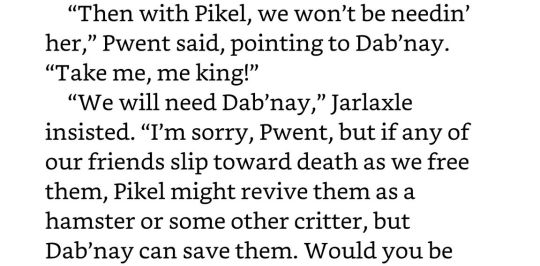
Although I’d relish an alternate universe in which Pwent got his way and events play out such that Drizzt and the CotH get reincarnated as slugs, I’m content for now that the existence of reincarnate is acknowledged. What Salvatore has written is also literally and exactly what reincarnate does: it brings the creature back to life, but in a random body. Salvatore FINALLY acknowledges that resurrection exists, and does so in the proper context of it being neither a big deal nor rare (at least, not to individuals who are supposed to be very powerful and resourceful as are the ones in his books). He even has the details of the spell mechanics to boot. Not going to lie, I was positively giddy about all of those things.
But that’s not all. The above passage only talks about resurrection, which would’ve been great enough and a breakthrough for Salvatore on its own, but later he has Dab’nay actually bringing someone back from the dead, and not just some no name tertiary character never to be mentioned again:
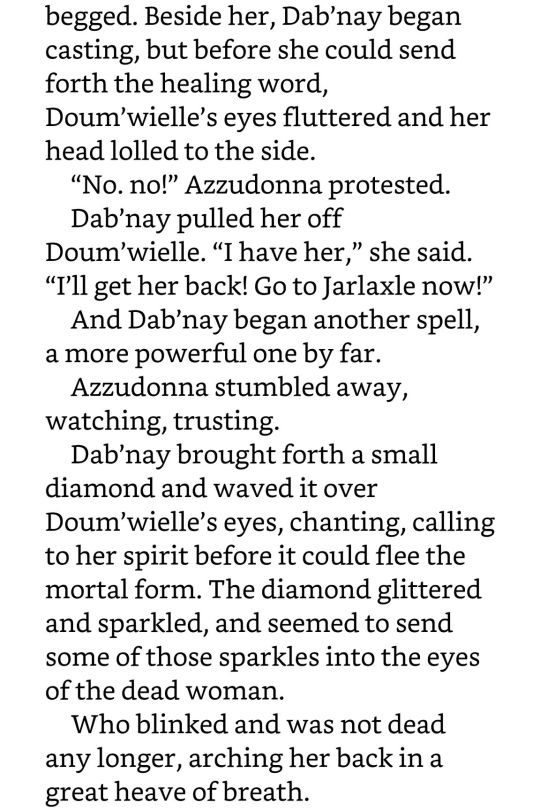
I’m still stunned. I can’t believe Salvatore actually wrote this. He doesn’t just imply that Doum’wielle died. There’s none of his usual handwaving maybe-this-happened-but-I’m-going-to-be-noncommittal about-it going on. He actually states that Doum’wielle was really dead, making it clear, without a doubt, the nature of the spell that Dab’nay uses, and by association, that it does exist in this world. He even gets the mechanics of the spell correct, namely the requirement for verbal, somatic and material components, the latter of which is the diamond. Given the description of the diamond as “small”, I would guess that it is the 300g variety, the smallest of diamond components in cleric resurrection spells. The spell would be revivify, which also fits in this case as Doum’wielle literally just died, and revivify only works on the target if it passed away within a minute. Being dead for longer wouldn’t be impossible to handle, it would just require more powerful spells and more expensive diamonds. I am extremely curious to see if Salvatore will continue to acknowledge and include the existence of resurrection spells in his future books. Not imposing artificial restrictions on common aspects of a world makes for so much better writing.
Respectable and Respectful Characterization
For the most part, characterization in Glacier’s Edge is sparse, leaving the reader feeling as though they’re watching different names drift across the pages rather than people enacting their roles. However, there are some exceptions to this pattern.
First, we finally see some age-appropriate behavior for Yvonnel the Second. Despite her magically-induced appearance as an adult drow female, she is actually only six years old. We’ve been told that her psyche matches her physical appearance due to being infused with Yvonnel the Eternal’s memories in the womb. However, much like how memory is (mis)handled in these books, which will be discussed more in a later section, memory doesn’t equate knowledge or character.
In Glacier’s Edge, Yvonnel 2.0 comes face to face with a very personal matter that hasn’t had a precedence in Lolthite drow culture for quite some time: the existence of maternal love. In the past, Yvonnel 2.0 treated Minolin Fey, her birth mother, with contempt and dismissal. Now, faced with the task of reforming Menzoberranzan, she realizes that she needs to start with changing how she herself behaves. However, she is woefully unprepared for this, and despite throwing herself into the task wholeheartedly, it is one of the very few times that we see Yvonnel 2.0 struggle to accomplish something:

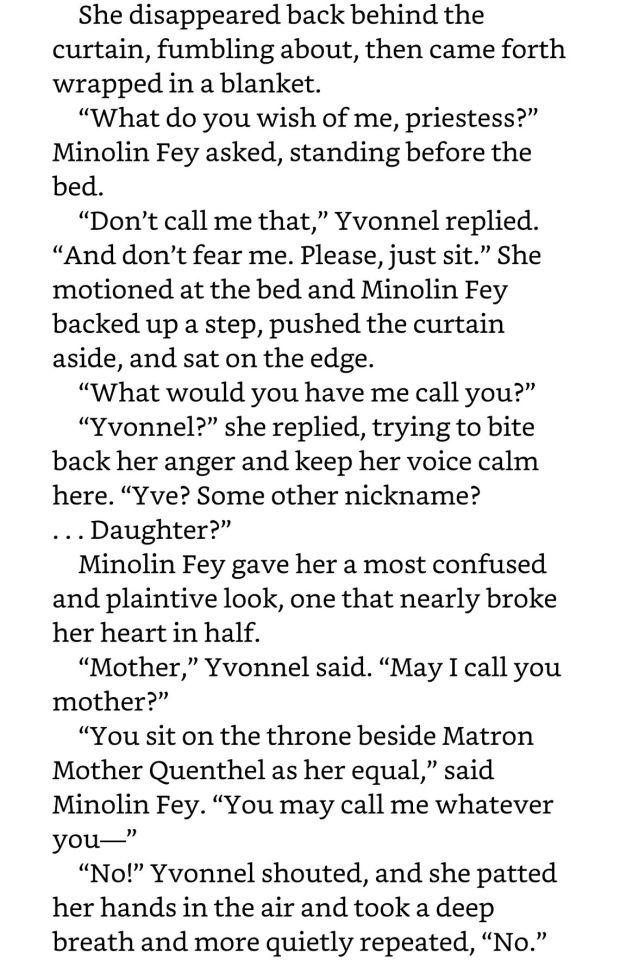
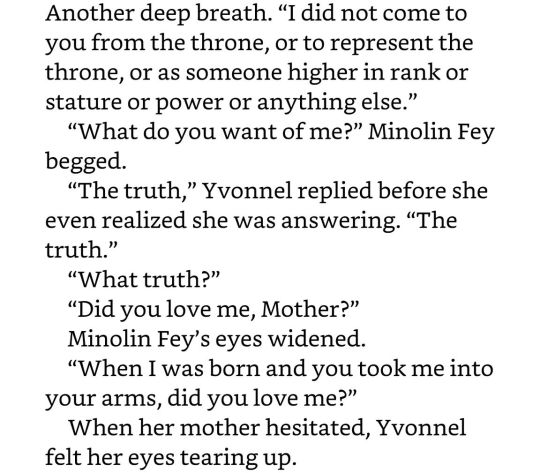
This confrontation is one of the few character portrayals in the entire book that rings true. Yvonnel throwing a tantrum against the door is so reminiscent of teenager angst, and so out of the norm for the normally extremely competent and composed priestess. What's more striking about this scene is how actively afraid of her Minolin Fey is, and how easy it is to imagine how that fear is amplified by Yvonnel asking something so wholly foreign to her. What makes it poignant is that Yvonnel wants Minolin Fey to immediately slip into habits that come naturally to her allies from the surface world, whose entire experience is so far from Minolin Fey's that the poor drow woman would've been less afraid were she facing an angry Yochlol instead. What's more, through what's fundamentally a clash of cultures between mother and daughter, it's the first time in a long while that a Drizzt book has stirred my emotions, for this scene calls to mind the many many struggles I experienced and witnessed growing up bicultural in the United States. Such a chasm need not be based in ethnicity either, cultural gaps between different generations can lead to the same type of occurrence. This rift, this invisible distance, the sense of incredible yearning on one side met with total confusion and inability to fulfill that deep desire on the other side, is what gives rise to modern tropes like the millennial parental apology fantasy. Fortunately for Yvonnel 2.0, she does eventually find what she seeks, in an implausible way that’s becoming a trademark for Salvatore, but nonetheless, for a little while, we bear witness to some rare and touching character development.
Gratuitous sex scenes, especially among the drow, has in the past been one of the themes that Salvatore would use quite frequently. Thankfully, he hasn’t done much of this in the more recent books, although it is somewhat strange that he has not included much sex at all. Thus, it was concerning when happening upon the sex scene between Dinin(ae) and another former drider, Aleandra. However, startlingly, this scene actually serves a purpose, and is rather tender and heartwarming to boot. Dinin and Aleandra are camping out in their battle stations, and during their turn on break, they begin to discuss life before becoming a drider, reflecting on all the things that their humanoid bodies could do that their drider bodies could not. This then leads to a spicier topic, and Aleandra propositions Dinin. Dinin initially turns her down, in large part because he’s reminded of his previous life in which females did not ask but commanded. To his great surprise, Aleandra, though hurt, backs off immediately and respects his wishes. Aleandra does so because she is from an era in which the Lolthite matriarchy did not exist, but nonetheless, this is an excellent portrayal of how important consent is, and is perhaps more convincing than any of the exposé about the aevendrow. In respecting his choice, his autonomy, Aleandra treats Dinin as a respected equal, and such treatment is the basis of goodness. The fact that Dinin ultimately accepts Aleandra and is the one to initiate the intimacy all while they themselves at the very heart of Lolthite society is more of a spit in the Spider Queen’s eye than all the bashing that Salvatore includes later.
Glacier’s Edge also does a good job of noting varying mindsets of former driders, who are now known as the Blaspheme. Having returned from the Demonweb Pits, a very good question is where they would end up once they die again, with Lolth being all that they’ve ever known:

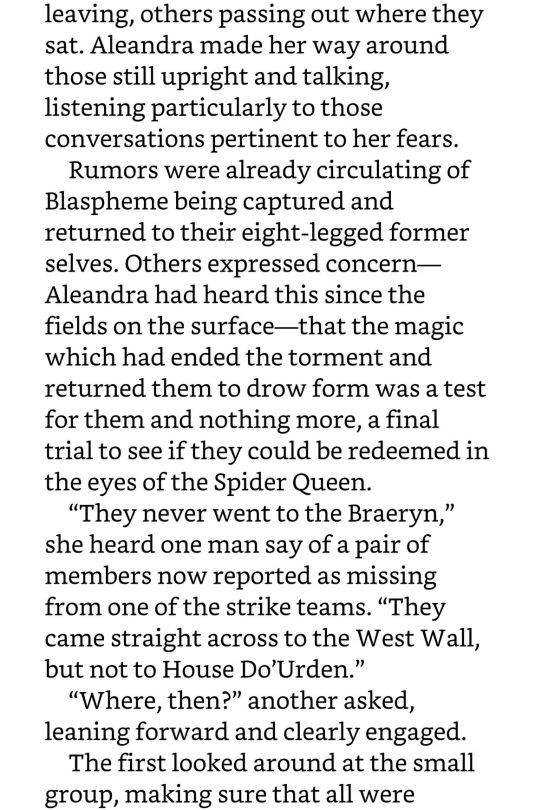

Although all of the driders had flung themselves through the transformative web to regain their drow bodies, Glacier’s Edge reveals that it didn’t equate to a unanimous turn against Lolth, even though the very act of undoing her curse is blasphemous against her. Much like with real people, the familiar can be more attractive than the unknown, even when the familiar is toxic. Further, much like real people, the Blaspheme convince themselves that it will be different, because not doing so would mean having to face the horrid truth, an act that’s just as scary as trying the unknown. It may very well be the case that the Blaspheme will willingly return to Lolth, although this is unlikely given the nature of the goddess, but regardless, it is a true to life portrayal of people.
I personally harbor a strong dislike for Drizzt due to the way that Salvatore portrays him, to the point that I’m not easily swayed due to the many books in which it’s shoved down our throats that he’s the embodiment of goodness. However, one scene in Glacier’s Edge improved my opinion of him. Grandmaster Kane recruits the copper dragon sisters Ilnezshara and Tazmikella to take them from the Monastery of the Yellow Rose back to Drizzt’s friends on the Sword Coast. Despite the agreement having already been established, and despite Grandmaster Kane already being in the process of mounting Tazmikella:


This one act of asking for consent is more convincing of Drizzt’s goodness than all of his journal entries, existing and to exist, ever will be. It shows him more worthy of respect than all the passages detailing his heroic exploits ever will. It doesn’t matter that Ilnezhara heartily approves and then proceeds to tease him with sexual innuendos alongside her sister, it doesn’t matter that we’re told that he’s afraid of how she can bite him in half. The very act of putting a saddle on a sentient creature, especially one as proud as a dragon who considers themselves superior to the races that are confined to walk on the ground, is inherently denigrating, and to then ride on that creature is even more so, no matter how it is played up to not be that way. Even though in practice, Ilnezhara holds all the power, the dynamic of mount and rider puts her in the lesser role, hence it’s so important that Drizzt treats her as a respected equal, maybe even further respecting her by implying that he acknowledges that she holds all the power.
In a book lacking much in the way of characterization, Archmage Gromph is the exception. In addition to being the only one who isn’t a raving fanboy of the Companions of the Hall, Gromph stays true to himself. It isn’t just haughty words and not at all empty threats against those who irk him, we see that Gromph hasn’t lost any of that hubris that’s made him appealing in his own way. After suffering a direct attack from a literal god, Gromph nonetheless remembers how to preen:


Gromph may not know that it’s a literal slaad god, but nonetheless, he knows the strength of his assailant. He’s grudgingly admitting that the creature is possibly stronger than him, after throwing a psionic attack that was only inferior to the collective might of one of the most powerful psionic entities in the multiverse. This does beg the question of just how powerful Gromph considers himself, but at the same time the answer doesn’t matter, for although he hasn’t met Elminster it’s pretty clear that he thinks he can take him. He’s wrong, of course, but nonetheless there’s a certain comical charm to Gromph pondering how awesome he is while facing down such a deadly foe. It’s incredibly fitting of him.
This concludes my section about the positives in Glacier’s Edge.
#legend of drizzt#Forgotten Realms#Glacier's Edge#The Way of the Drow Trilogy#Drizzt#Drizzt Do'Urden#R A Salvatore#book review#ooc
6 notes
·
View notes
Text
Relentless live-read! [through chapter 10]
Not quite as much to say about these chapters; plot’s moving forward a bit, or at least all the pieces are drawing closer to the board. And, as always with drow, I feel I need some kind of visual aid to keep track of who’s got what plan and who’s going to backstab who. That part at least is nice to see in this, oddly enough, because at least the drow are acting like drow.
Though what would also help would be if the Matron Mothers didn’t all sound exactly alike, if they had personalities beyond ‘ambition’ and ‘religious fervor’. (And where did Minolin Fey Baenre grow those pair of ovaries to stand up to the drider like that? and then immediately revert to her usual status at the bottom of the pile?)
At least Braelin showed up and I got ridiculously excited to see my favorite side-character in this.
Also I am now taking bets on Malagdorl demanding to fight someone he really should know better than to fight and not ending up well. (Grandson of a certain weaponmaster and that extra? Though that’s a thought, there are a lot of grandsons running around in this series. I would almost expect this to be a point or a theme, but it’s not nearly well-developed enough for me to be sure about that.)
3 notes
·
View notes
Text
State of the noble drow houses after the event of "Lolth's Warrior" — a Drizzt novel possibly set very closely before the events of Baldur's Gate 3.
note: the first book stated that it was set in 1490, two years before the events of BG3 (1492), it is not state clearly how long time has passed by the 3rd book (Lolth's Warrior), but I got an ask on here said it's set in 1491. Take it as you will.
Might be helpful if you have a drow noble Tav who's from one of the existing noble houses (and is romancing Minthara, who's from house Baenre, who had amazing insults for house DeVir in game)
To recap: The houses were in a civil war, one side fought against Lolth and her grip on drow (house Baenre and their allies: house Do'Urden/Xorlarrin, house Fey-Branche) and the other, for Lolth (or at least, against the Baenre and in fear of Lolth's wrath) (house Barrison Del'Armgo and their allies: house Melarn, house Mizzrym, house Vandree, house Hunzrin; & loyal Lolthian priestess Sos'Umptu Baenre). The loyal side won, with Sos'Umptu replacing her sister as Matron Mother of house Baenre, 2500-3000 drows left the Underdark including the former Baenre Matron, all part of the deal that placed Sos'Umptu to the throne. Around 3000 drows were dead in the conflict, countless demon banished for 100 years.
House Baenre: Sos'Umptu Baenre is now the Matron Mother. She's a devoted Lolth High Priestess, Mistress of Arach-Tinilith, daughter of Yvonnel the Eternal and sister of former Matron Mother Quenthel Baenre, who's now in exile on the surface. Two of Quenthel's children stays, including her eldest daughter. Half of the drider-turned-drow soldiers stayed. Yvonnel Baenre II is not dead, but currently is banished somewhere unreachable by the Avatar of Lolth.
House Barrison Del'Armgo: Matron Mez'Barris Armgo (and some of her priestesses) is dead at the hands of her mind-controlled grandson — weapon master & Lolth's Warrior — Malagdorl Armgo.
House Melarn: Matron Zhindia Melarn got blown up in their house compound, possible structural damage there. Lolth's Web fell, wounded many including those of house Melarn.
House Xorlarrin/Do'Urden: Matron Zeerith Xorlarrin became Zeerith Do'Urden for the restored house Do'Urden and now reverted to Zeerith Xorlarrin, having embraced Lolth once again and turned her back at Quenthel Baenre and Yvonnel's cause. The Matron's daughter — her heiress left the Underdark with her brother.
House Fey-Branche: Matron Byrtyn Fey is the mother of Minolin Fey and grandmother of Yvonnel Baenre II. She got turned into a drider, implied to be Zhindia Melarn's handiwork. She's alive still and so is her daughters.
House Mizzrym: Miz'ri Mizzrym & allies stormed and seized the compound of house Fey-Branche. Matron Byrtyn Fey was captured during this raid and turned into a drider.
House House Faen Tlabbar: Stayed out of the conflict. Remained intact.
House Vandree: Matron Asha Vandree is alive. Lost a nephew in this conflict.
House Hunzrin: Matron Shakti was held captive at the hands of house Baenre, but is implied that they're to be released when Sos'Umptu take charge of house Baenre instead of Quenthel.
#lore#read: lolth's warrior#ive edited this post too many times i think im just gonna. hit post#minthara#drow
77 notes
·
View notes